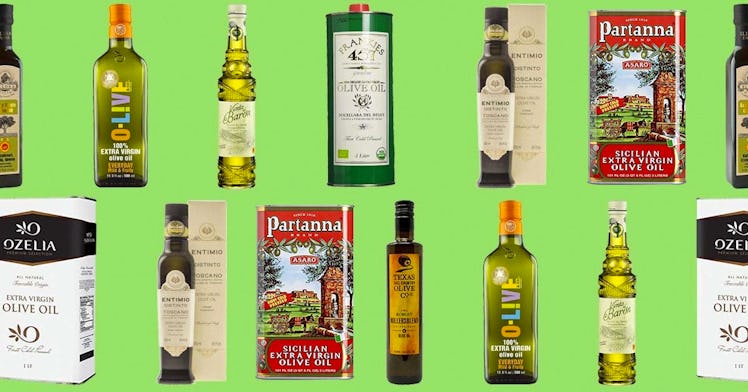The Best Extra-Virgin Olive Oils To Fire Up Your Taste Buds
It's liquid gold, baby.

Ask any Italian chef how to elevate nearly any dish, and he or she will advise you to buy a bottle of the best olive oil you can afford. That’s not hyperbole — we asked Greg Bernarducci, owner of the boutique olive oil shop O Live Brooklyn in New York, and that’s literally what he said. Bernarducci didn’t stop there; he kept going, diving into the minutiae of the 3,0000-year-old kitchen aid and providing a host of other tips on finding the best bottle for you. Whether drizzled on homemade pasta, shaken into salad dressing, substituted for butter in baking, or used to sauté vegetables your kids will actually eat, the best olive oils are a wildly versatile fat that enlivens every food it touches.
When it comes to the best olive oil brands today, extra virgin olive oil (or EVOO, in the parlances of experts) is king. The highest standard for olive oil bestowed by the International Olive Council, extra virgin olive oil is made from pressed olives without using heat or chemicals and has no defects or refinements. Even so, not all oils are created equal. There are different bottles, prices, and stamps of designation. There are also different flavors: some herbaceous, others peppery or grassy. Some are very light in taste. So how do you find the best extra virgin olive oil? Bernarducci graciously broke down his selection process so that you can choose wisely and eat better.
5 Tips for Choosing the Best Olive Oil
Check the harvest date. According to Bernarducci, an olive oil should be used within 12 to 14 months of its harvest date (sometimes called a crush date). “This date can be really hard to find, and many brands won’t have it, although you’ll have more luck in a store like Whole Foods,” he says. If you’re ordering online, ask the seller to confirm the harvest date before you complete your purchase.
Note the country (or countries) of origin. The harvest season for northern hemisphere growing regions (such as Europe) tends to be in November, while it’s May for southern hemisphere spots like Australia and South America. Bernarducci says that sometimes companies will blend olives from different countries together, which isn’t a huge deal unless they’re from different hemispheres. “Think about it, if it contains oils from, say, Spain and Chile, those are two different hemispheres, so obviously some oil was sitting around for a long time before it was blended—that should be a flashing light,” he says.
Avoid refined oils. Sometimes companies blend extra-virgin olive oil with refined olive oil, which has been heavily processed. (You can spot it because instead of just “extra-virgin olive oil” the label may say “light” or “pure” olive oil, two terms that are just marketing jargon.) “The process of refining uses very high heat, even higher than cooking, as well as chemical solvents that can strip out flavor and health benefits,” he says.
Remember HALT. That stands for heat, air, light and temperature, all of which will shorten your olive oil’s life. Don’t choose a product in a clear bottle (it should be tinted glass or a tin) and don’t store your oil near the stove. Keep it tightly closed in a cool, dark spot like a pantry, and it should last about four to six months after you open it. “I advise customers to not buy too much, because if you go through it fast, a larger bottle is a better value, but if it will sit around, I recommend a smaller one,” he says.
Taste it. It might sound odd to slurp it straight from a spoon, but that’s the best way to get a sense for your chosen oil’s freshness and flavor. “Good olive oil should have an herbal, almost grassy taste, and it should be kind of pungent so it makes you cough. You might also taste hints of pepper, green banana, tomato or artichoke,” Bernarducci says.
Every product on Fatherly is independently selected by our editors, writers, and experts. If you click a link on our site and buy something, we may earn an affiliate commission.
The Best Extra Virgin Olive Oils
This article was originally published on